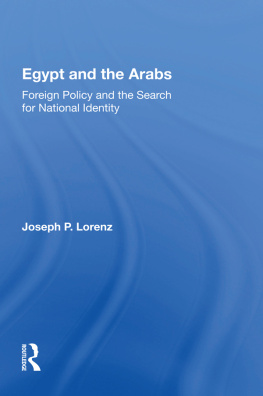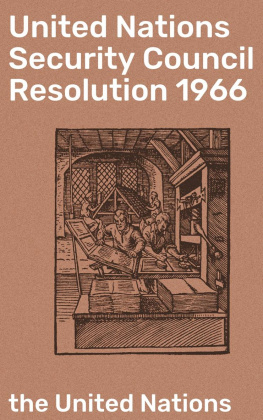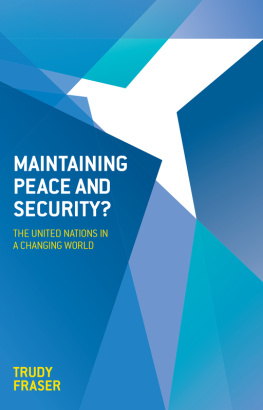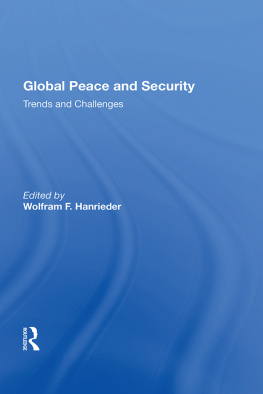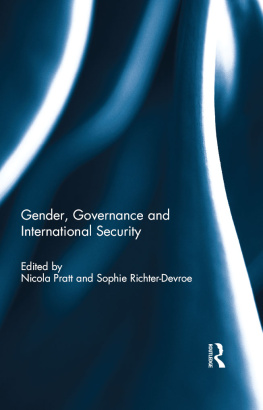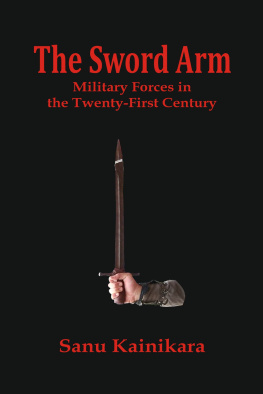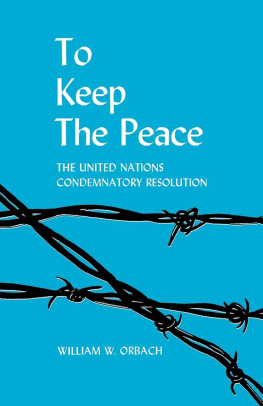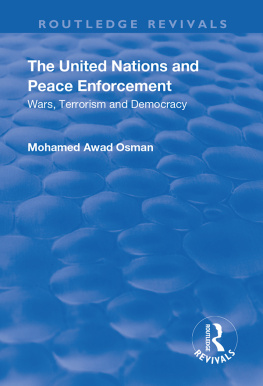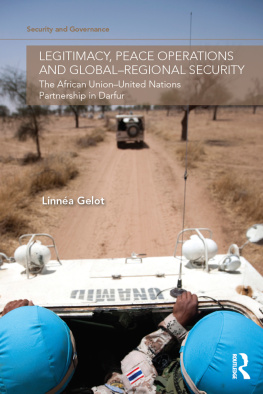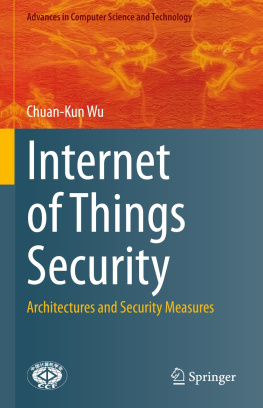First published 1999 by Westview Press
Published 2019 by Routledge
52 Vanderbilt Avenue, New York, NY 10017
2 Park Square, Milton Park, Abingdon, Oxon OX14 4RN
Routledge is an imprint of the Taylor & Francis Group, an informa business
Copyright 1999 by Taylor & Francis
All rights reserved. No part of this book may be reprinted or reproduced or utilised in any form or by any electronic, mechanical, or other means, now known or hereafter invented, including photocopying and recording, or in any information storage or retrieval system, without permission in writing from the publishers.
Notice:
Product or corporate names may be trademarks or registered trademarks, and are used only for identification and explanation without intent to infringe.
Library of Congress Cataloging-in-Publication Data
Lorenz, Joseph P.
Peace, power, and the United Nations: a security system for the
twenty-first century / Joseph P. Lorenz.
p. cm.
Includes bibliographical references and index.
ISBN 0-8133-8061-8 (hc)
1. Security, International. 2. Peaceful change (International
relations). 3. United NationsArmed Forces. I. Title.
JZ5588.L67 1999
341.5'84dc21 98-42242
CIP
ISBN 13: 978-0-367-28250-9 (hbk)
For their help at several stages in the preparation of this book, I am indebted to former colleagues at the U.S. Mission to the United Nations and the Department of State's Bureau of International Organizations, as well as to scholars in the field and my wife and daughters. My special thanks to David Popper, Robert Rosenstock, Samuel Lewis, Michael Newlin, Gerald Helman, Robert Oakley, Inis Claude, and Townsend Hoopes.
I am also grateful to the U.S. Institute of Peace for its financial support, its stimulating seminars and working groups on post-Cold War collective security, and its patience in bearing with changes in the book's focus and subject matter as new threats to peace and security led to new approaches to the use of collective force.
Joseph P. Lorenz
Peace, Power, and the United Nations
The notion that every state has an interest in the territorial integrity of every other stateno matter how distant they are and how slight their connectionsis peculiar to the twentieth century. To be sure, poets and philosophers had perceived humanity's common interest in preventing wars, and statesmen had found that aggression from outside the community could be deterred by the mutual defense of those within it. But no one had ever tried to organize an all-embracing system that used the collective force of its members to prevent one of them from attacking another.
It took the wide devastation of two world warsarid the failure of the balance-of-power systems that preceded themto instigate the search for a more effective way to manage power. To the founders of the League of Nations and the United Nations there was nothing extravagant about the idea that peace is indivisible. Their countries had been drawn into wars that were largely not of their making: They had learned that to control their destinies they must act early, with others, to keep the peace. It is this core of national self-interest that drives collective security. If the system works at any moment in history, it is because its members believe they have enough stake in the existing order to warrant taking measures against any nation that threatens to destroy the fabric of that order.
The reamers of the League Covenant and the UN Charter did not view the systems they were establishing as permanent methods of international cooperation applicable to all power configurations at all times. They were less interested in theory than in the practical problem of managing postwar relationships more systematically than alliance systems had done in the past. The irony, of course, is that both post-world war periods turned out to be very different from what the framers had anticipated, though not too different from what they had feared.
Because of U.S. nonparticipation in the League of Nations and the Cold War's paralyzing effect on the United Nations, the collective-security measures of the League Covenant and the UN Charter have never been applied in the ways envisaged. We cannot be certain if the system's underlying political assumptions are valid or if it can be made to work under certain conditions of power distribution, great-power relationships, developing-world interests, and the like. The chief question at the close of the twentieth century, as in 1918, concerns the willingness of states to participate in military enforcement actions at the direction of others in situations that do not affect their vital interests. There is considerable skepticism that nations will behave in this way but not much analysis of how, and in what circumstances, they might be brought to do soat least not since the end of the Cold War.
With the breakup of the Soviet Union, a new international order is emerging with its special problems, relationships, and forms of power, How applicable the UN collective-security system is to this new order and how realistic its assumptions are in a world of competing national interestsis the first of the two main questions this book tries to answer. For these collective-security issues, the U.S.-led enforcement action against Iraq is the principal case study. The second question concerns the steady run of ethnic and factional wars within states, which have emerged as a central problem of post-Cold War politics. Here the UN intervention in Somalia serves as the main case study. The Somalia crisis illustrates the limits of armed intervention in the internal violence that flows from intercommunal antagonisms and the drive for power in failed states. One thread that runs through the bookfrom the "peace enforcement" operations in Africa to the great-power tripwire missions in the Balkans and the Persian Gulfis the relationship between consensual peacekeeping and mandatory enforcement action, and the uses of both in regional conflict prevention.
These issues are examined from the viewpoints of history, theory, and practice. Collective security cannot be fully understood without a grasp of its early uses and theoretical roots, and the opening chapters consider the system from these perspectives. (The specialist may wish to skip, which are designed primarily to provide background for students of international organizations and foreign affairs.) The case studies were chosen for their contemporary relevance, but they also reflect my own familiarity with a number of UN operations from my work on UN peace-and-security issues at the U.S. Mission to the UN and the State Department. That work persuaded me that a modified version of the UN collective-security system, combined with peacekeeping innovations that have evolved since the end of the Cold War, offers increased flexibility in preventive diplomacy, a greater measure of deterrence, and a means of handling secondary threats with secondary responses. In short, it is a way to avoid the all-or-nothing approach to international involvement.
A main line of argumentation in the chapters on collective security concerns the formation of an international deterrent force under .) Any UN force that was established today would look very different from the body the UN's founders had in mind. Changes in the power situation over the last half century would have a major impact on the size, scope, and purposes of a contemporary force. Most important is the change in the nature of the primary threatfrom the global expansionism of potential world powers like Germany and Japan in 1945 to the regional ambitions of expansionist middle powers today. Any system intended to contain these regional powers must adjust to two developments in the nature and distribution of modern weapons. First is the huge gap in nuclear and conventional arms sophistication that has developed between the middle powers and the major status quo states. But second, raising the need for an effective system of deterrence to a new level of urgency, is the development of suitcase bombs and anthrax weapons that can be infiltrated into the territory of one's enemies.


